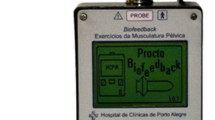Abstract
PURPOSE: This study was undertaken to assess the functional results of biofeedback training in patients with fecal incontinence in relation to clinical presentation and anorectal manometry results. METHODS: Twenty-six consecutive patients with fecal incontinence were treated with biofeedback training using anorectal manometry pressure for visual feedback. Ten patients had passive incontinence only, six patients had urge incontinence, and ten patients had combined passive and urge incontinence. RESULTS: Patients with urge incontinence had a lower maximum voluntary contraction pressure (92 ± 12 mmHg) and lower maximum tolerable volume (78 ± 13 ml) than patients with passive incontinence (140 ± 43 mmHg and 166 ± 73 ml). Twenty-two patients completed the treatment, five patients (23 percent) showed excellent improvement, nine patients (41 percent) had good results, and eight (36 percent) patients showed no improvement. At follow-up on average of 21 months after therapy, 41 percent of our patients reported continued improvement. The maximum tolerable volume was higher in those with excellent (140.4 ± 6.8 ml) or good (156.3 ± 6.64 ml) results of therapy than it was in those with poor results (88.5 ± 2.5 ml). Greater asymmetry of the anal sphincter also correlated to poor results. CONCLUSION: Biofeedback therapy improved continence immediately after training and at follow-up after 21 months, but the initial results were better. The urge fecal incontinence seems to be related to function of the external anal sphincter and to the maximum tolerable volume. Low maximum tolerable volume and anal sphincter asymmetry were associated with a poor outcome of therapy
Similar content being viewed by others
References
Engle BT, Nikoomanesh P, Schuster MM. Operant conditioning of rectosphincteric responses in the treatment of fecal incontinence. N Engl J Med 1974;290:646–9.
Cerulli MA, Nikoomanesh P, Schuster MM. Progress in biofeedback conditioning for fecal incontinence. Gastroenterology 1979;76:742–6.
Loening-Baucke V. Efficacy of biofeedback training in improving faecal incontinence and anorectal physiology function. Gut 1990;31:1395–402.
Macleod JH. Management of anal continence by biofeedback. Gastroenterology 1987;93:291–4.
Wald A. Biofeedback for neurogenic faecal incontinence: rectal sensation is a determinant of outcome. J Pediatr Gastroenterol Nutr 1983;2:302–6.
Buser WD, Miner PB. Delayed rectal sensation with fecal incontinence: successful treatment using anorectal manometry. Gastroenterology 1986;91:1186–91.
Latimar PR, Campbell D, Kasperski J. A components analysis of biofeedback in the treatment of fecal incontinence. Biofeedback Self Regul 1984;9:311–24.
Whitehead WE, Burgio KL, Engel BT. Biofeedback tratment of fecal incontinence in geriatric patients. J Am Geriatr Soc 1985;33:320–4.
Wald A. Biofeedback therapy for fecal incontinence. Ann Intern Med 1981;95:146–9.
McHugh S, Kersey K, Diamant NE. Biofeedback training (BIO) for fecal incontinence (FI): outcome according to physiological parameters [abstract]. Gastroenterology 1988;94:A295.
Sangwan YP, Coller JA, Barrett RC, Roberts PL, Murray JJ, Schoetz DJ Jr. Can manometric parameters predict response to biofeedback therapy in fecal incontinence? Dis Colon Rectum 1995;38:1021–5.
Berti Riboli E, Frascio M, Pitto G, Reboa G, Zanolla R. Biofeedback conditioning for faecal incontinence. Arch Phys Med Rehabil 1988;69:29–31.
Goldenberg DA, Hodges K, Hersh T, Jinich H. Biofeedback therapy for faecal incontinence. Am J Gastroenterol 1980;74:342–5.
Delechenaut P, Leroi AM, Weber J, Touchais JY, Czernichow P, Denis P. Relationship between clinical symptoms of anal incontinence and the results of anorectal manometry. Dis Colon Rectum 1992;35:847–9.
Engel AF, Kamm MA, Bartram CI, Nicholls RJ. Relationship of symptoms in faecal incontinence to specific sphincter abnormalities. Int J Colorectal Dis 1995;30:152–5.
Johansson C, Nilsson BY, Holmström B, Dolk A, Mellgen A. Association between rectocele and paradoxical sphincter response. Dis Colon Rectum 1992;35:503–9.
Gee AS, Durdey P. Urge incontinence of faeces is a marker of severe external anal sphincter dysfunction. Br J Surg 1995;82:1179–82.
Engel AF, Kamm MA, Sultan AH, Nicholls RJ, Bartram CI. Anterior anal sphincter repair for patients with obstetric trauma. Br J Surg 1994;81:1231–24.
Read M, Read NW, Duthie HL. Effects of loperamide on anal sphincter function in patients comlaining of chronic diarrhea with faecal incontinence and urgency. Dig Dis Sci 1982;27:807–14.
Rao SS, Read AW, Davison PA, Bannister JJ, Holdsworth CD. Anorectal sensitivity responses to rectal distension in patients with ulcerative colitis. Gastroenterology 1987;93:1270–5.
Varma JS, Smith AN, Busuttil A. Correlation of clinical and manometric abnormalities of rectal function following chronic radiation injury. Br J Surg 1985;72:875–8.
Devroede G, Vobecky S, Masse S. Ischemic fecal incontinence and rectal angina. Gastroenterology 1982;83:970–80.
Cann PA, Read NW, Holdsworth CD, Barends D. The role of loperamide and placebo in the management of the irrtiable bowel syndrome. Dig Dis Sci 1984;29:239–47.
Alstrup NL, Rasmussen OO, Christiansen J. Effect of rectal dilation in fecal incontinence with low rectal compliance: report of a case. Dis Colon Rectum 1995;38:988–9.
Miner PB, Donelly TC, Read NW. Investigation of the mode of action of biofeedback in treatment of fecal incontinence. Dig Dis Sci 1990;35:1291–8.
Arhan P, Faverdin C, Devroede G,et al. Biofeedback reeducation of faecal continence in children. Int J Colorectal Dis 1994;9:128–133.
Author information
Authors and Affiliations
About this article
Cite this article
Glia, A., Gylin, M., Åkerlund, J.E. et al. Biofeedback training in patients with fecal incontinence. Dis Colon Rectum 41, 359–364 (1998). https://doi.org/10.1007/BF02237492
Issue Date:
DOI: https://doi.org/10.1007/BF02237492




